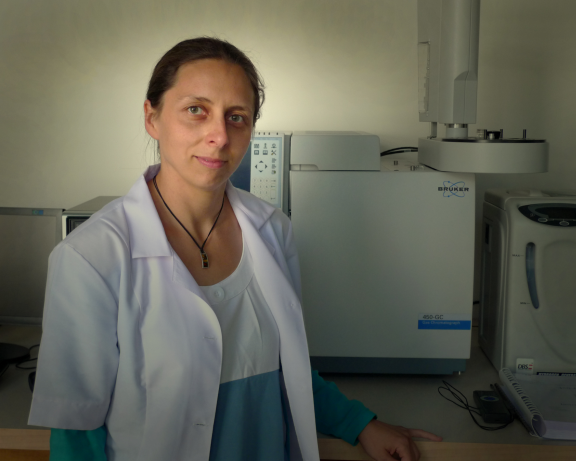Stanowisko: Adiunkt
Pokój: 106
Telefon: 42 631 35 18
E-Mail: dorota.gryglik@p.lodz.pl
Wykształcenie:
- Uniwersytet Łódzki, Wydział Biologii i Nauk o Ziemi, 1999 mgr, „Oznaczanie mesny w moczu ludzkim metodą wysokosprawnej chromatografii cieczowej”;
- Politechnika Łódzka, Wydział Inżynierii Procesowej i Ochrony Środowiska, 2005, dr „Fotochemiczne generowanie tlenu singletowego do degradacji wybranych zanieczyszczeń w środowisku wodnym”.
Wybrane publikacje:
Gryglik, D; Olak, M; Miller, JS "Photodegradation kinetics of androgenic steroids boldenone and trenbolone in aqueous solutions" Journal of Photochemistry and Photobiology A-Chemistry 2010, (212), 14-19.
The subject of this study was photodegradation of boldenone and trenbolone belonging to the class of compounds which demonstrate endocrine disrupting activity. Their decomposition was carried out on the pathway of 254 nm photolysis alone and in the presence of hydrogen peroxide. The influence of pH, oxygen content in the reaction mixture, initial substrate concentration, photon fluence rate and initial concentration of H2O2 on the reaction rate was investigated. The effect of radical scavenger on the reaction course was also tested. The obtained results were used to determine kinetic parameters. Quantum Fields of boldenone and trenbolone decay were equal to 0.61±0.02 and 0.0029±0.0002, respectively. The estimated rate constant of the reaction of hydroxyl radicals with trenbolone was (4.3±0.8)×109M−1 s−1.
Błędzka, D; Gmurek, M; Gryglik, D, et al. "Photodegradation and advanced oxidation of endocrine disruptors in aqueous solutions" Catalysis Today 2010, (151), 125-130.
Endocrine disruptors, sometimes also referred to as hormonally active agents, are exogenous substances that act like hormones in the endocrine system and disrupt the physiological function of endogenous hormones. Our recent studies concern degradation of some representatives of this class of chemicals: n-butylparaben (BP), 4-t-octylphenol (OP), trenbolone (TB) and boldenone (BD). We applied three methods for their elimination from aqueous solution: photolysis by 254 nm irradiation, advanced oxidation process using hydroxyl radicals and photosensitized oxidation using mainly singlet molecular oxygen. The kinetic parameters of those processes were calculated. The most efficient degradation of studied compounds was observed in H2O2/UV system.
Gryglik D., Lach M., Miller J.S. "The aqueous photosensitized degradation of butylparaben" Photochemical & Photobiological Sciences 2009, (8), 549-555.
The photosensitized oxidation of butyl p-hydroxybenzoate (butylparaben, BP), the endocrine disrupting compound, in aqueous solution using rose bengal (RB) and aluminium phthalocyanine chloride tetrasulfonic acid (PC) as sensitizers was examined. A xenon lamp simulating solar radiation was used as a light source. The influence of pH of the reaction mixture, oxygen content, irradiation intensity and initial sensitizers and BP concentration on the reaction rate was studied. Based on the kinetic model, the rate constants of singlet oxygen quenching and reaction with BP as well as the rate constant of excited sensitizer quenching by BP were determined.
Gryglik D., Miller J.S., Ledakowicz S. “Singlet molecular oxygen application for 2-chlorophenol removal” Journal of Hazardous Material 2007, (146), 502-507.
A special kind of photocatalysis—a photosensitized oxidation involving singlet molecular oxygen (1O2) was applied to decomposition of 2- chlorophenol (2-CP) in water solution. The photoprocess was carried out in a homo- and heterogeneous system using rose bengal (RB) as a sensitizer. In the homogeneous solution the influence of initial 2-CP concentration and pH on reaction rate was observed. Based on the kinetic model, the rate constants of 1O2 quenching and reaction with 2-CP and the rate constant of excited sensitizer quenching by 2-CP were determined. In the heterogeneous system, silane gel was a carrier for the immobilized sensitizer. In order to estimate kinetic parameters, an attempt was made to describe the process using Langmuir–Hinshelwood (L–H) type mechanism. The Langmuir equilibrium constants for oxygen and 2-CP adsorber on the gel surface were also estimated.
Gryglik D., Miller J.S., Ledakowicz S. “Solar energy utilization in degradation of 2-chlorophenol by immobilized photosensitizers” Solar Energy 2004, (77), 615-623.
The aim of this work was to examine photosensitized oxidation of 2-chlorophenol using solar light. Rose bengal, methylene blue and chlorin e6 were used as sensitizers which were immobilized in the silane gel and used in the form of a thin film covering glass plates. In some lab-scale experiments xenon arc lamps were used as solar simulators. The influence of various experimental conditions (light intensity, the amount of sensitizer, oxygen concentration) on the rate of 2-chlorophenol degradation was investigated. The obtained results indicate a possibility of the application of solar radiation in the middle latitudes for wastewater treatment. The use of silane gel as a carrier for the sensitizer enables the pollutants elimination at a higher rate than in a homogenous system. The stability and durability of immobilized sensitizers were also studied.
